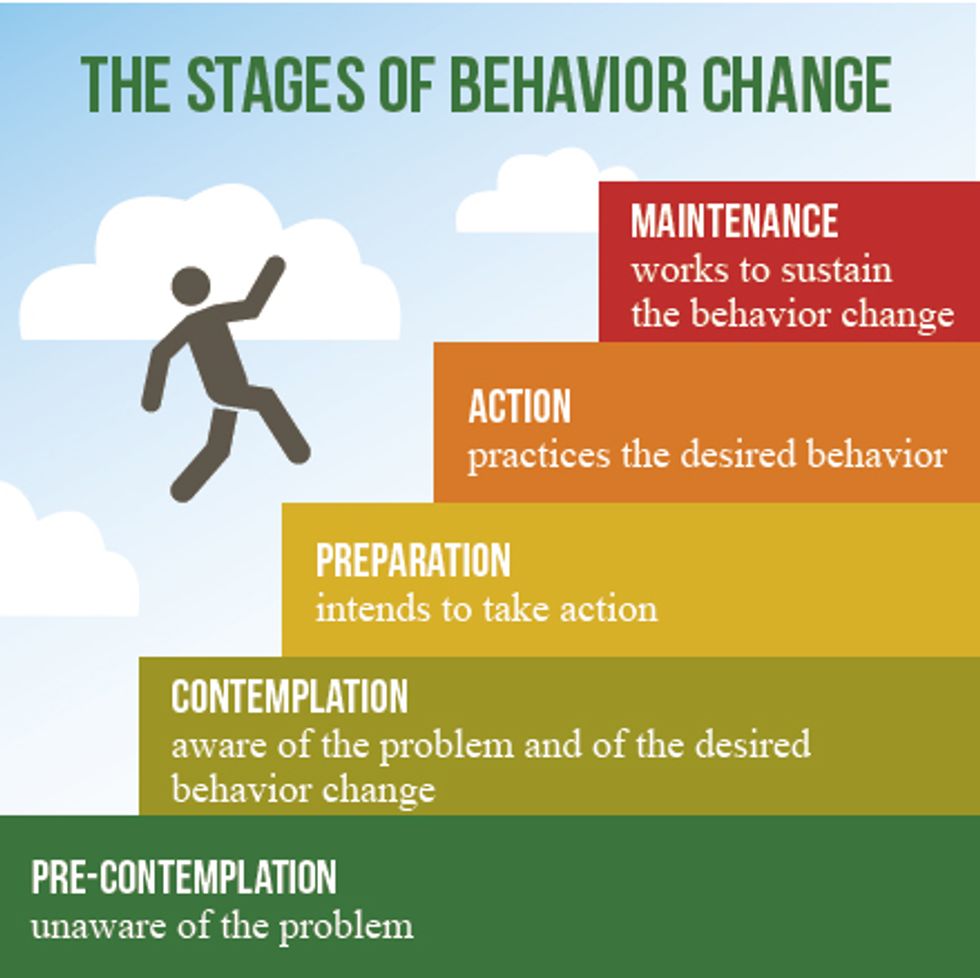Are you into New Year's Resolutions? Personally, I'm not. I generally prefer to set goals on my own time, instead of letting a particular time of year influence me. Still, a lot of people use the start of a new year as motivation to make and break habits: new year, new me. I'm always impressed when someone is still maintaining that personal goal into February.
Let's be honest: change is not easy. If you've been a dedicated carb-lover for years, or if you've never felt that "runner's high" after a workout, it can be really hard to stick to your new goals. It gets even harder when the habit you're trying to break is addictive and unhealthy: nicotine use, overeating, alcohol dependence, etc. I'm taking an Addictions course this year, where I've learned just how much addictive behaviors affect the brain (here's an article that explains it, if you're interested).
So, how does change actually happen? Here's want I wanted to show you today: a bunch of really intelligent people came up with this thing called the "Transtheoretical Model" of change. If you enjoy that big word, here's another: this model takes a biopsychosocial approach to the process of behavioral change. That means it tries to incorporate biological, psychological and sociological explanations for behavior. While it is most often used in the treatment of addictions, the transtheoretical model applies to any kind of behavioral change, both breaking habits and making new ones.
Here's the fun part: you can use this model for yourself and for others in your life. It's incredibly straightforward to understand, and has given me some excellent insight into why it's so hard for me to develop new habits. I want to walk you through the five stages of change, and explain the best way for you to encourage yourself (and others) through them.
1. Pre-contemplation.
This is almost a fake step, because change isn't really even being considered yet. This is where you hear phrases like "I know I should eat healthier, but I just love carbs," or "I'm just really not a runner." People in this stage have no intent to take action, even if they are aware they "should."
How to pass this stage: unfortunately, unmotivated people aren't likely to suddenly become motivated. While many people remain in pre-contemplation out of ignorance or lack of awareness of how changing might help them, some people just don't care. If you are in pre-contemplation, the best way to get out of it is to imagine what life might look like if you change; maybe this will help build motivation.
2. Contemplation.
This is the stage where intent to change starts; a person in contemplation is ready to try something new. More than just being ready, the person in contemplation is thinking about the pros and cons of changing; they know what will make it hard, but are willing to try anyway. Don't be confused though: we aren't anywhere near action yet. A person can stay in the contemplation stage for years, ready to start but never actually making a plan.
How to pass this stage: the key here is moving from passive contemplation to active planning. Someone in the contemplation stage needs to process through what they will gain and lose by changing, and accept their own dissatisfaction with where they are.
3. Preparation.
Imagine someone preparing to jump: freeze them at the point where they have bent their legs and are tensing their muscles to spring upward. This is what preparation looks like. It is distinguished from contemplation by a formulated plan to act. Changing is no longer an abstract concept: instead of "getting more exercise," a person in preparation is thinking about how many days a week they will go to the gym. They have specific ideas of how to accomplish their goal, and intend to start those behaviors in the next month.
How to pass this stage: the key to moving from preparation to action is specificity: the more specific a plan is, the harder it becomes to put things off. Instead of saying, "soon I'll start cutting back on sugar," challenging the individual to set an exact date when the change will start. Keep developing a clear plan for how to maintain the change and what to do if the person "relapses" to the original behavior.
4. Action.
Congratulations!! This is where the rubber meets the road. No matter how long the previous three stages took, they were leading up to this point and have contributed to real change. In the action phase, you start having tangible evidence of the change you desire, and that can make you feel quite accomplished. It's good to remember that the new behavior isn't a habit yet; it will require the same effort and intentional work all the way through.
How to pass this stage: based on the transtheoretical model, the individual needs to be in action at least six months before moving to maintenance. Don't believe what you've heard about "21 days to form a habit;" that's a total myth. The only way maintain action is time and dedication. That's why the action stage is at great risk for a relapse into old behaviors.
5. Maintenance.
So it's been six months, and the new behavior has become familiar. Wow! Honestly, I am always amazed when people make it this far, because it takes serious commitment and hard work. When someone is in maintenance, they no longer need to work so hard to maintain the new behavior. This doesn't mean there's no risk of going back to the old behavior; that can take up to five years. However, the maintenance stage is like the last mile of a marathon.
How to pass this stage: "moving forward" is sort of a moot idea at this point; the purpose of the maintenance stage is to become comfortable being where you are. The best way to keep this going is to keep the vigilant attitude that got you this far. For every behavior, there are factors that make it easier and factors that get in the way. Knowing what factors encourage you towards an old, unwanted behavior will help you avoid things that might put you back where you started. Conversely, factors that encourage your new self should be pursue and held onto.
So, now you know what the Stages of Change model is. Guess what? This is the very same model that helps people out of drug or alcohol addiction; this is the same model that helps people towards a new lifestyle of health and fitness that saves them from severe health concerns. This model is for everyone.
Now that you know what the model looks like, you might gain a new understanding of why your friend always complains about wanting to get more sleep, but never goes to bed early. You might sheepishly realize (like I did) that you've been in the contemplation stage about having a daily quiet time for years, because you never actually made a plan of how to do it. You might realize that you've finally made it to the action stage when it comes to getting exercise, but that you've still got a long way to go before it feels comfortable.
So, what behaviors are you trying to stop or add to your life? Where are you on this model? I encourage you to start using this tool and the language it gives you. If you can start understanding why, the how might feel a lot more accessible.




















